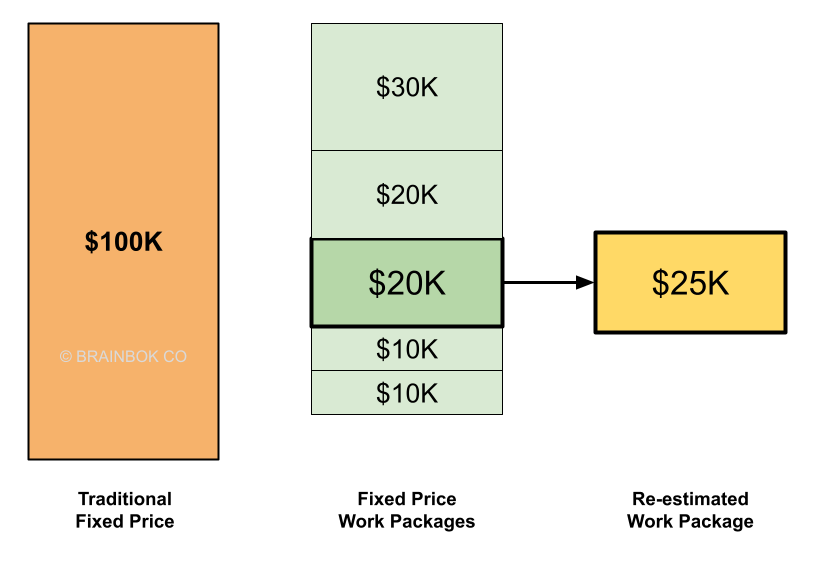The first value in the Agile Manifesto states “Customer Collaboration over Contract Negotiation”. Instead of adopting a win-lose attitude toward procurements, buyer and seller should adopt a collaborative approach based on shared-risk-reward leading to a win-win situation.
Waterfall vs Agile Contracts
| Waterfall | Agile |
|---|---|
| Fixed scope; time and cost are estimated | Flexible scope; fixed time and cost |
| Requirements and end product are clearly defined | Requirements and product evolve with time |
| Delivery at the end | Continuous delivery throughout the project |
| Changes are tightly controlled | Changes are welcome even late |
| Strictly follow the contract | Collaborative approach |
| Rewards based on effort instead of value | Pay for value instead of effort |
| Focuses on processes instead of vision | Shares vision, not process |
| Assumes lack of trust between parties | Assume parties act in good faith |
| Discourages continuous improvement and limits innovation | Rewards the contractor for increased efficiency |
Examples of Agile Contracts
Multi-Tiered Contract
Instead of locking all the terms in a single big contract, parties can achieve more flexibility by using multiple contracts for different aspects of the project.
- Fixed items (e.g., warranties, arbitration) can be locked in a master agreement.
- Subject to change items (e.g., product description, service rates) can be added to a schedule of services.
- Dynamic items (e.g., scope of work, schedule, budget) can be added to the statement of work.
Emphasize Value Delivery
About 80% of the value comes from about 20% of the features. Traditional contracts have milestones or phase-gate based deliverables that limit the use of feedback to improve the product. Instead, if the payment terms are tied to value-delivery it provides for an opportunity to prioritize the highest-value features, and end the contract early if the project runs out of budget.
Money for Nothing, Change For Free
Money for nothing is a fair way to end the contract early if the value has been delivered. For example, a customer may decide to end the contract when 80% of the value has been delivered, and in return pay the seller a percentage of the remaining budget as compensation. In other words, the customer and seller split the remaining budget say in a 80:20 ratio i.e. the seller gets 20% money for nothing, while customer saves 80% of the remaining budget on features that were probably never going to be used. As a bonus, the project gets completed early.
Change for free implies scope can be changed without worrying about scope creep. It allows for low-priority features to be replaced with high-priority features of the same value (effort) at the end of an iteration. For example, a customer may replace 3 small features amounting to 5 days of effort, with a single higher priority features that amounts to the same effort.
Graduated Fixed Price Contract
In this model, the customer pays the seller a standard rate if the contract gets delivered on time. But if the contract is delivered early, the seller gets paid at a higher rate. The customer is happy because the contract is completed early, and they might pay less money overall. The seller is also happy because they get a higher margin from the contract. On the other hand, if the seller delivers late, they get paid at a lower rate. Both parties are somewhat unhappy in this case. The customer is unhappy because the contract is late, and they might end up paying more overall. The seller is unhappy because their profit margin is reduced. Therefore, this type of contract incentivizes higher efficiency on the part of the seller.
| Project Completion | Graduated Rate/Hr | Hours Charged | Total Cost |
|---|---|---|---|
| Early | $110 | 900 | $99,000 |
| On time | $100 | 1000 | $100,000 |
| Late | $90 | 1200 | $108,000 |
Fixed Price Work Packages
Instead of estimating the all the work into a single fixed price contract, the work is split into smaller deliverables called work packages. The estimation is done at the individual work package level. This approach mitigates the risk of overestimation or underestimation at the beginning of the contract. The seller also has the option to reestimate the remaining work as they gain more experience and insight during the course of the project. This reduces the need for the seller to build additional contingency in their estimates, and generally results in lower contract cost. If a work package’s estimate goes up, it’s easy to identify the reason and request for additional budget.

Summary
Agile contracts are based on collaboration and trust. They promote transparency and include the provision to inspect and adapt the work. Sellers get the flexibility to revise their estimates during the course of the contract, and do not need to build contingency in their estimates. Customers get the option to re-prioritize work, request changes, provide feedback, and end the contract early when adequate value has been delivered. Sellers can play their part by delivering early and often, and customers play do their part by providing frequent feedback.